In Off the Top, presented at the Soho Playhouse, Baba Brinkman created a series of raps explaining and delving into mysteries of neuroscience, while his wife, neuroscientist Heather Berlin, presented the scanned images she had created of his brain while engaged in rapping. Brinkman moved to freestyle, and we saw how this sort of live quick engagement interacted with his neurological processes. This was theatre as science lecture, or vice versa, and the evening was as entertaining as it was informative.
Another recent work that tackled neuroscience was Jon Torn’s The Scientist, a piece of reader’s theatre—a pared-down, dramatized lecture—which played at the So-Fi Festival. Accompanied by video and live music, Torn narrated the unique life of neuroscientist John C. Lily, who found ways to control monkey brains with electrodes and took part in extreme experiments with LSD in an attempt to see more deeply into his own consciousness. By transforming a lecture into theatre, Torn (like Brinkman) lets the two forms speak to each other, engaging the emotions while engaging the intellect.
The most prominent recent production, and the most conventional, was of Tom Stoppard’s The Hard Problem at Lincoln Center. The title refers to the problem of understanding consciousness. But unlike many of the other productions of this genre, or even Stoppard’s previous work combining theatre with science (such as Hapgood and Arcadia), The Hard Problem plays like a relatively mundane drama. Though it is full of Stoppard’s usual sparkling dialogue, it suffers for its inability to match form to concept. Neuro-theatre demands innovation. Such a young scientific field needs to be complemented by productions that are shaped by the content.
Neuro-theatre demands innovation. Such a young scientific field needs to be complemented by productions that are shaped by the content.
An interesting conversation between Stoppard and cognitive scientist David Chalmers, who originated the term “the hard problem of consciousness”—the difficulty of explaining the reason why any organism is aware of its own experiences—highlights the lost promise of the play, because the concepts behind the problem of consciousness are fascinating. I have not yet seen Brinkman’s current work, Rap Guide to Consciousness, but perhaps it is more successful at tackling that same subject.
What feels true to me, regardless, is that the number of productions matching neurology and neuroscience with theatre is hardly a coincidence. The connection between understanding the brain and understanding human behavior is apparent. As the fields of neurology and neuroscience expand and evolve, something needs to fill the gap between pure scientific analysis and what it means to us all as humans. What better medium than theatre to do so?
Neuro-theatre seems to have evolved from simply being theatre on a specific topic to being its own sub- genre. Few artists work exclusively in it—which makes it clear that it is not an independent genre—though most people who do seem to create at least somewhat experimental work in general. Like much of this kind of work, neuro-theatre is usually innately structural and meta-theatrical. But its language is the language of science, full of beautifully complex jargon. At its best, it is also a deeply emotional form, not just because of the emotion of viewing the brain, but also because emotion is itself a function of the brain.
In his book Consilience, biologist E. O. Wilson argues that the separation of art and science is a modern phenomenon, and it is only by combing the two, like the Greeks of old, that we can gain new insights into both areas. And in that moment of combination, the science and the art are both rejoined and transformed. The potential for truly understanding ourselves as humans lies within that synthesis. If that is not the goal of theatre, what is?



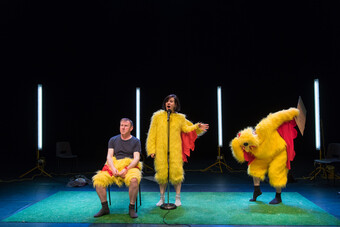




Comments
The article is just the start of the conversation—we want to know what you think about this subject, too! HowlRound is a space for knowledge-sharing, and we welcome spirited, thoughtful, and on-topic dialogue. Find our full comments policy here
I can offer a couple of other examples for people interested in this topic. Thanks for getting it going, Edward.
If you're not already familiar with the work of Back To Back Theatre, in Geelong, Australia, take a look. They are a 30-year-old company of artists with a range of intellectual disabilities, the term they have come to land on to describe their ensemble, that regularly tours major performing arts centers and festivals in the US. They'll be back next season. They also make films and videos with neuro-diverse communities and you can see some of them on their site.
I will also never forget Joseph Chaikin's performance in "Texts for Nothing" at Magic Theatre back in the late nineties. It was one of several productions he either performed or directed around the world following a stroke that induced aphasia. Samuel Beckett wrote is final poem, What is the Word, for Mr. Chaikin.
The subject of companies that use neurodivergent performers is fascinating and important, though for me in a a different category from what I can neuro-theatre, ie performance with neurology or neuroscience as its subject. Of course, it can be both, There is also the category of performance of theater specifically created for those on the spectrum. And theater being created by those like Chaikin who are experiencing their own neurological conditions. Like many theatrical forms, there are many variations that speak to each other, and at times they overlap. The reason that I define neuro-theatre so specifically is that I think it relates to questions of structure and style.
This is a great piece, Edward. If you haven't seen Rap Guide to Consciousness and are going to be in NYC soon, it has been reprised along with two other of Baba Brinkman's best-loved shows at the SoHo Playhouse.
Feb 13 Wednesday 9pm
Mar 5 Tuesday 7pm
Mar 19 Tuesday 7pm
Apr 2 Tuesday 7pm
Apr 7 Sunday 7pm
Last year, Lab of Misfits (the world’s first neuro-design studio and public perception research space) included the show as part of a series of experiments to examine the power of live performance and the effect of those experiences on the brain. They recorded data from the brains of participants at the show using state-of-the-art surface electrode caps as they experience a video or live performance. They filmed that performance and showed the video to a different set of subjects the next day, to see what kinds of differences occur in the brain between watching live vs pre-recorded performances. We are excited to get the results of the study.
I think I may have seen that video--in fact, I think we may have invited them to be part of our neuro art exhibit for The Neurology of the Soul. We actually have a lot of neuro art in the lobby, I would love for you to see it if you can drop by. Our shows are Thu - Sat at 8pm; Sun Feb 10 & 24 at 5pm; Tue Feb 12 & 26 at 7pm, through March 2, at the A.R.T./New York Theatres, 502 W. 53rd Street. Heather Berlin will be doing a talkback on Thu Feb 21 and all the artists are doing a talkback on Fri Feb 15. Let me know if you want to drop by!
Fantastic article—thanks for bringing together so many great examples, and to pointing to design, Puppetry, and visual theater as rich domains of expression and investigation that go beyond the confines of descriptive language and the real human body. One side note—your line about the lack of familiarity with Asperger’s by people at the O’Neill really surprised me and doesn’t fit with my perception of folks in that population or in the greater puppetry community. In my experience, given our work in neurodiverse educational settings and the existence of a significant population of Muppet fans with AS, puppeteers are almost hyper-aware of Asperger’s and Autism, and many (including Pam at the O’Neill, Z. and Cheryl at the Henson Foundation, Aretta at the Center for Puppetry Arts, Eric and Shoshi at Sandglass Theater, Z. Puppets Rosenshnozz in Minnesota, and our team in Boston) are connected to initiatives to engage this population in new and exciting ways. Perhaps these could be future avenues of collaboration, along with other science/theater initiatives such as the Catalyst Collaborative at Central Square Theater.
Thanks Roxana. I definitely know Z and Pam are well aware nowadays of all these questions of neurodiversity. My time at the O'Neill was 2005, nearly 15 years ago (Z was also in her first year attending, I believe), and part of what I was trying to highlight was that the world has radically changed since that time. In fact, despite my current immersion in that world, I think the first time I heard the term neurodiversity was about six months before that, as a meeting for people with Asperger's. It's wonderful to me to see how quickly the puppetry world has become responsive to all these issues.